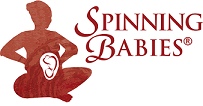Right obliquity refers to a normal shape of the human uterus. With obliquity, or angling, to the right we see a steeper side to the uterus on the right and a more round side on the left. A baby lying along the right side of the uterus would then have a straighter back. A baby on the left side could cuddle into the curve. The angle of the spine leads the angle of the head.
The straight back lifts the chin in extension or a neutral head, chin up but not extended as if looking up, star gazing. The curved back also curls the neck, tucking the chin. As we mentioned before, the tucked chin offers a smaller head circumference and more fetal participation in wiggling through the pelvis.
Right Obliquity in Literature
There is little mention of right obliquity in current literature. Jean Sutton brought awareness of right obliquity to popular attention in the late 1990s through her book with Pauline Scott, Understanding and Teaching Optimal Foetal Positioning (New Zealand). Old text mentioned Right Obliquity as in this example below, along with solutions that have since been researched with limited success.
 Illustration: Pictorial Midwifery 1948, Berkeley
Illustration: Pictorial Midwifery 1948, Berkeley
Western obstetrics adds dextro-rotation of the uterine muscles in addition. This is a spiral action of the muscle layer. Dextrorotation is mentioned when fetal rotation is claimed to be counterclockwise. Russians are skeptical and follow the findings of medical researcher Savitsky from Saint Petersburg, also active in the 90s.
Savitsky is interesting. He says that muscles spindles create a pathway for uterine contractions to create a fluid hydraulic pump action presumably for blood traveling in vessels along uterine muscles and lymph interstitially between the muscles cells. With this fascinating description, contractions are better dehttps://www.spinningbabies.com/wp-content/uploads/2019/10/sample3-1.pngd as surges, literally. Electrical signals recorded by the monitor show these surges as wave patterns. Could both dextro-rotation and muscle spindles be present in one or more of the three uterine muscle layers? I would love someone to send more research papers my way!
Uterine Torsion
A twist, or torsion, in the uterus was also called uterine obliquity in medical literature. Look at more than one source to follow the conversation of the day. A spiral could be called a twist, for instance, but the degree varies.
Today, a 45-degree twist is labeled uterine torsion. Better known by veterinarians caring for cows, torsion happens in human uteruses, too. The spiraling action of the contracting or surging uterus does seem effective in rotating babies. Too much twist can create the need for an emergency cesarean. The baby just won’t come out. A little twist seems to cause posterior or for some breeches, the head-up position. Transverse lie after 30 weeks gestation in the absence of a placenta previa or twin seems to be caused by torsion and if so, easily addressed with multiple Forward-leaning Inversions in a 24-hour period.
Right Obliquity Techniques
Right obliquity is normal. It’s in many uteruses. You noted it as a student when learning to measure up the center of the uterus in the 2nd trimester and noting that the right side of the uterus was often higher than the center of the fundus. This is not due to the baby being on the right but rather the right obliquity.

Now mobilizing the fascia where it connects with the muscle and pelvis, along the borders, is helpful in “making space for the baby”. The 30-35 week fetus can then easily move from side to side and the older fetus can settle on the left. Our “release” based techniques from the bodywork world, especially those designed and promoted by Dr. Carol Phillips, DC. are foundational. More finesse is needed when baby remains “shrink-wrapped” by tight ligaments into one position on the right side, especially in the first baby. Explore our Techniques section or attend a Spinning Babies® Workshop.
References
Savitsky, A. G., Savitsky, G. A., Ivanov, D. O., Mikhailov, A. V., Kurganskiy, A. V., & Mill, K. V. (2013). The myogenic mechanism of synchronization and coordination for uterine myocytes contractions during labor. The Journal of Maternal-Fetal & Neonatal Medicine, 26(6), 566-570.
Enjoy this post? You also might like:
- Fetal Engagement from the Right
- Maternal Positions at the Levels of the Pelvis
- Course of Fetal Position Changes
- Why this is not Optimal Fetal Positioning
Upcoming Workshops
[tribe_events_list limit=”4″]

